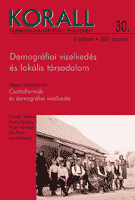„Elváltak” és „válások”. Családi állapot és jogintézmény a 19. század második felében Budapest (Pest-Buda) példáján
'Divorced' and 'Divorce' – Marital Status and Legal Institution in the Second Half of the Nineteenth Century: The case of Budapest (Pest-Buda)
Author(s): Sándor NagySubject(s): History
Published by: KORALL Társadalomtörténeti Egyesület
Summary/Abstract: Historians studying divorce generally suggest that the nineteenth century was the age of secularisation and describe a trend – the onset of the present-day growth path of divorces –, which seems to prefi gure the future (our present) undisputedly. Thus, whereas studies of earlier periods usually assume a culturalanthropological approach, examining their subject from an appropriate distance and focusing on the meaning of individual decisions, divorce in the second half of the nineteenth century is often painted as familiar, mensurable, and comparable to our day and age. As opposed to this, present study approach the constructs of the legal institution (divorce) and marital status (divorced) critically through the peculiar development of marriage law in the Hungarian capital and in general. An inconsistency is revealed about the surveys of Hungarian censuses concerning the divorced population (which, at the time, included informally divorced Catholic couples too): the census data repeatedly indicate more divorced women than men, even though in the case of Budapest, where the same phenomenon is found, the ratio of remarrying men and women is only 10:9. As the most likely explanation for this, the paper suggests a ‘tendency to hide’ among the divorced population, and especially among men. Two particular case studies are given as examples for the falsification of real marital status by divorced women in the capital, and at the same time, the author stresses the possibility of societal control with regard to the name of married women. The hypothesis is that it was easier for divorced men to be overlooked in administration, such as in censuses. Furthermore, the author refines the hypothesis of ‘witholding information’, and draws attention to the uncertainties about the contemporary meaning of the term ‘divorced’, and its use in everyday life. Using dictionaries, census instructions, and marriage certifi cates from Budapest, Nagy addresses the possibility of blurring the diff erence between estranged spouses and offi cially divorced couples, as well as the various alternative terms used to signify the marital status of offi cially divorced persons (e.g. widow(er), ‘szabados’, ‘ledig und frei’). Finally, specifi cally Hungarian anomalies of the legal institution itself, that is, the termination of marriages, are discussed. On one hand, the termination of Catholic marriages became possible after 1868, however, if either of the spouses remained in the Catholic faith, the marriage remained binding for him/her. On the other hand, the parallel and often overlapping secular-ritual practices of terminating Jewish marriages resulted in similar uncertainties. In both cases the same question may arise: who was considered ‘divorced’ after all?
Journal: Korall - Társadalomtörténeti folyóirat
- Issue Year: 2007
- Issue No: 30
- Page Range: 142-157
- Page Count: 16
- Language: Hungarian

